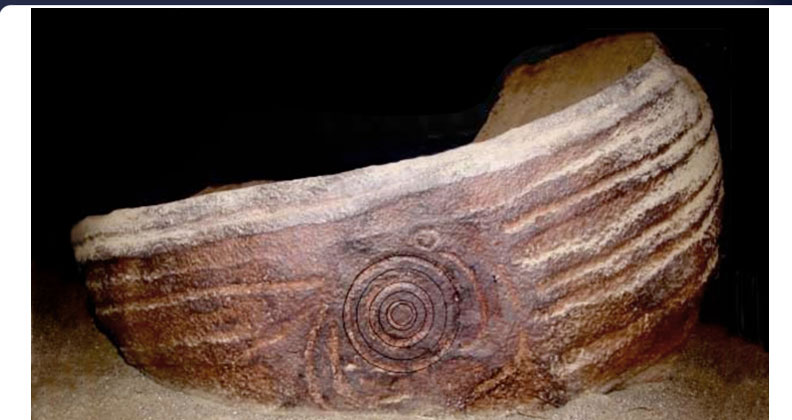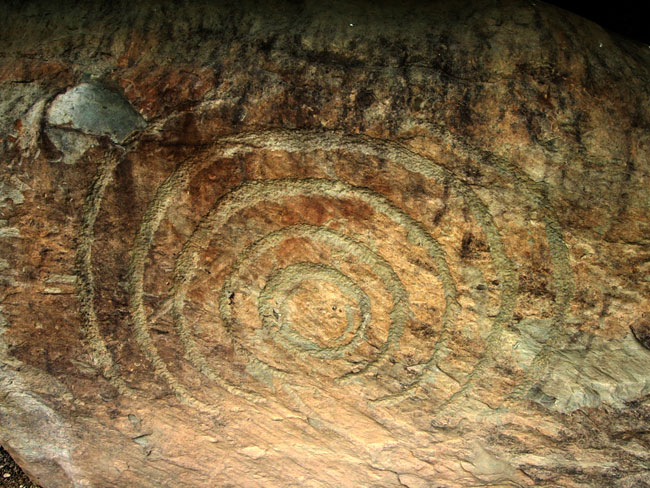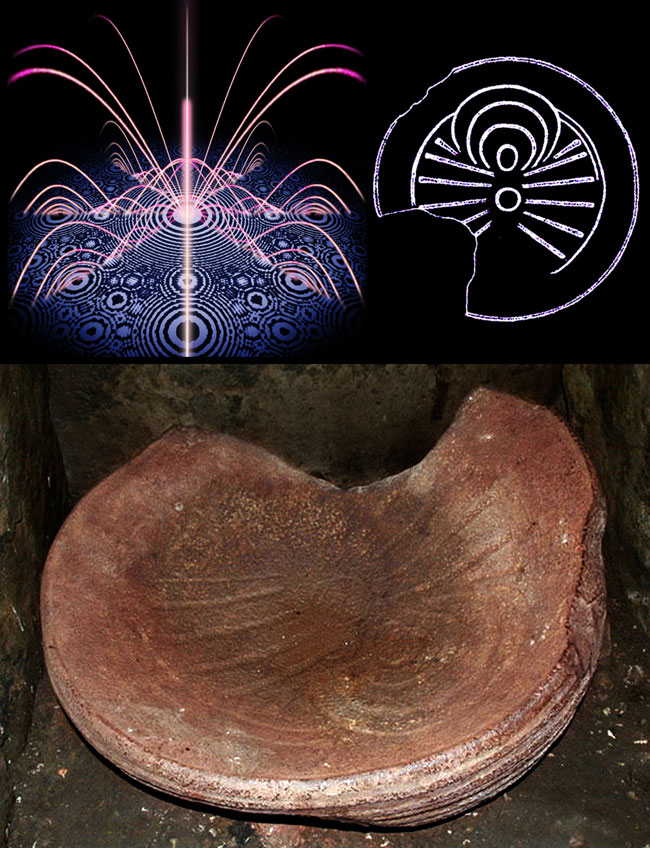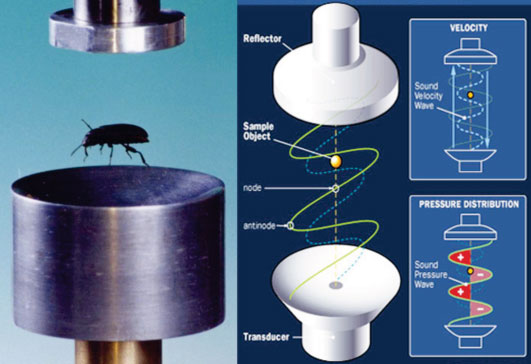




Standing Waves Depicted on Stone Levitation Basins at Knowth, Ireland
Stone Basins at Knowth Megalithic Chamber Designed for Acoustic Levitation
by Alex Putney for Human-Resonance.org
August 27, 2011
Enigmatic finds from ancient megalithic sites, temples and pyramids around the world provide an emphatic answer to the glaring question of how these same megaliths were erected. At each of these monumental sites archaeologists are unable to find any basic stone carving tools, nor any recognizable tools that may have been used in their transportation and building phases. This inconsistency points to one solution only: the giant stones were levitated using advanced acoustic resonance technologies.
Giant stone basins were found at the terminations of the megalithic passage chambers of Knowth (seen above) and Dowth, in Ireland, and have also been discovered at various pyramid sites along the Nile River including several stunning examples of quartz and limestone basins. The walls of the passage chambers in Ireland, including Newgrange with its dramatic solstice alignment, are lined with massive megalithic limestone blocks, engraved with psychadelic swirling patterns and sets of concentric circles (below).

The concentric circles carved into the ceiling, walls and artifacts at Knowth reflect the same geometric symbols engraved at other sacred sites, such as Gavrinis passage chamber in Brittany, France, that make unmistakable references to the acoustic structure of nonlinear standing waves (illustrated below).
The large granite bowl discovered at Knowth also displays concentric circles on its round sides, with horizontal ridges encircling the entire instrument. The concave basin itself is engraved with a clear geometric diagram of standing waves (compared below). The central circle with radiating lines represents the primary infrasound transducers at Giza, while the three frequencies in Fibonacci ratio produced by the three Orion pyramids are shown as three standing waves arching up above the ground plane:

The specific and exclusive use of piezoelectric calcite and quartz crystals for the construction of the megalithic chambers and pyramids themselves, and the large basins that once surrounded them in great numbers, relates to their transducive capacity to focus and amplify acoustic waves. Mechanical flexing occurs in the quartz and calcite crystals as a uniform structural deformation that generates standing waves within the stones' crystalline lattice, eventually building a strong electromagnetic field that allows acoustic levitation.
Infrasonic stimulation of solar flare activity has been correlated to river flow and precipitation rates. Could it be that the pyramids and megaliths were designed to increase atmospheric evaporation by heartbeat resonance? The high-resonance form of hydrogen is called protium, being the lightest hydrogen isotope, known for its powerful rejuvenative effects, in stark contrast to the cellular aging induced by heavy water. The levitation of water by solar-driven infrasound resonance allows separation of lighter protium water molecules from the heavier isotopes of deuterium and tritium (above).

Acoustic engineers have developed small, concave piezoelectric transducers enabling the generation of standing waves for acoustic levitation. Both water and small living organisms (like the beetle, above) have been levitated using ultrasound, while the ancients used giant low-frequency transducers. During the conquest of the Americas, historian Garcilaso de la Vega documented the destruction of giant granite bowls at Inca sites in the Andes having diameters that exceeded the height of two men. Just as in the case of the pyramid chambers, the world's megalithic chambers also produced lightwater vapor.
Both the piezoelectric properties and the perfectly formed concavities of the large, ancient stone basins confirm their utility as precision instruments for acoustic levitation, and their cultural context informs us that water was being levitated. This conclusion is also directly supported by the cosmology of the ancient stepped-pyramid-building cultures of the Maya and Aztec, who speak very clearly in the Pyramid of Fire Codex about the separation of terrestrial and celestial waters - referring to the resonant solar infrasound separation of pure protium from the low-resonance isotopes of deuterium and tritium:
Chalchiuhtlicue, Goddess of Terrestrial Waters, of that which flows, runs, surges, forward and down...
Chalchiuhtlicue fills the gourd of pulque so that man may forget...
Tláloc, God of Celestial Water... god of the mist that ascends from the valleys at dawn...
Tláloc is the return of vapor that strains to rise, is the return of time that strains to remember.
Longevity and cellular rejuvenation were imbued by drinking lightwater in the resonant infrasound environment of the pyramid and megalith chambers, filled with lightwater vapors separated by levitation in large piezoelectric stone basins.
Deep heartbeat booming emanating from the Giza pyramids resounded loudly at various bands of resonant focal points throughout the world network, based on the quadratic function [ zn+1 = zn2 ]. The distance from Giza to the Irish sacred sites of Newgrange, Knowth and Dowth is 10.0% of the Earth's mean circumference distance (of 24,892 miles). Stonehenge, England lies at the 9.0% distance from Giza, while the sacred stone temples of Machu Picchu, Peru and subterranean caverns of La Maná, Ecuador sit exactly along the 30.0% distance from Giza. Mexico's Teotihuacan pyramid complex and the Nazca Lines of Peru sit along the 30.9% distance corresponding to Fibonacci #138. These perfect distance relationships reveal a systematic global alignment.